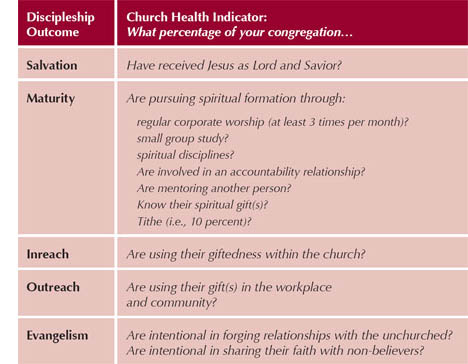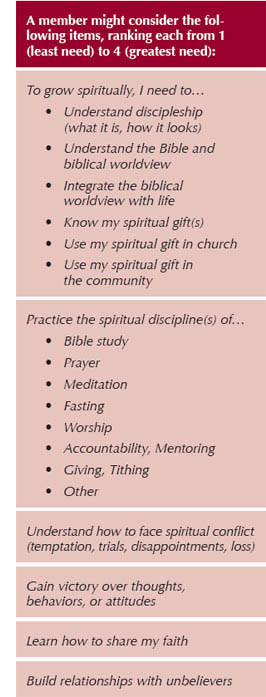Back to series



Getting Intentional about Discipleship
Click here to open a Print - Friendly PDF
Jesus was intentional about discipleship. For three years he invested himself in the lives of twelve men who would eventually take up the work he had begun. He gave them a call (to follow me), a command (to love as I have loved), and a commission (to make disciples).
From the Sermon on the Mount to the Emmaus Road, they received instruction, object lessons, and discipline to prepare them for their disciple-making work. Eleven completed the program and, after Pentecost, began preaching the gospel, living the revolutionary way of life they had learned from their Lord.
 The rapid growth of their numbers and the peculiar quality of their community captured the attention of skeptics and curiosity-seekers alike. In an early second century letter to “Diognetus”--a well-placed pagan desiring to learn about the Christian faith--the author shares: “Christians are distinguished from other men...[by] their wonderful and confessedly striking method of life.”
The rapid growth of their numbers and the peculiar quality of their community captured the attention of skeptics and curiosity-seekers alike. In an early second century letter to “Diognetus”--a well-placed pagan desiring to learn about the Christian faith--the author shares: “Christians are distinguished from other men...[by] their wonderful and confessedly striking method of life.”
The author goes on to describe, at some length, the attitudes and behaviors of a community that exhibited a moral standard that was odd and unfamiliar, yet winsome.
Fast-forward nearly nineteen hundred years.
Sixteen Percent
In 2007 George Barna found that born-again Christians were “statistically indistinguishable” from their non-Christian neighbors in 15 moral behaviors (including lying, gossiping, substance abuse and extra-marital sex). Two years later, Barna observed that 66 percent of American adults are what he terms, “Casual Christians.”
Casuals are self-identified Christians who “do not view matters of faith as central to one’s purpose or success in life.” Casuals want a low-demand faith, one that helps them feel religious and be better people, without having to take a stand on moral issues. Barna calls it “faith in moderation.” I think “lukewarm” was how Jesus put it.
By contrast, “Captive Christians” are believers whose lives “are defined by their faith.” They have high commitment in “serving Christ and carrying out His commands and principles.” As Dietrich Bonhoeffer would say, theirs is a faith of costly grace established on the Cross of salvation and the Yoke of discipleship. Sadly, Barna reports that Captives comprise only 16 percent of adults. Sixteen percent!
The United States is the most Christianized nation on the planet in terms of per capita churches, clergy, religious education, and educational resources. It has the most Christians--nearly twice as many as the next highest country, Brazil--and yet, only 16 percent could be considered followers of Jesus Christ.
Are we surprised, then, that there is little difference in the moral behaviors of Christians and non-Christians? Are we shocked when yet another denomination adopts heterodox theology or endorses unbiblical practices? Are we stunned that mainline churches are in decline and that youth are heading for the exits at record levels? Are we dismayed that the Church has lost its moral voice in an increasingly secular culture? If we are, we shouldn’t be.
Course Correction
As lamentable as these things are, they are the predictable fruits of decades and generations of non-discipleship Christianity. Although job one of the Church is (and always has been) to make disciples, most churches have not made discipleship a priority. Dallas Willard calls this our “Great Omission.”
Few churches give their congregations any compelling vision of discipleship. Fewer put discipleship expectations on their members beyond regular attendance and giving. And fewer still have a discipleship process that includes: spiritual health assessments and monitoring, personal spiritual growth plans, needs-related resources for spiritual development, and teaching, preaching, and programs structured around discipleship outcomes.
 If the Church is to reverse its course and reclaim its calling as a culture-shaper, it must get intentional about discipleship. And that starts by defining what discipleship is all about. For example: “Discipleship is a life-long process, transforming believers to think, act and love like Jesus which begins, inwardly, with personal response to the gospel and moves outwardly with a passion to advance the Kingdom.”
If the Church is to reverse its course and reclaim its calling as a culture-shaper, it must get intentional about discipleship. And that starts by defining what discipleship is all about. For example: “Discipleship is a life-long process, transforming believers to think, act and love like Jesus which begins, inwardly, with personal response to the gospel and moves outwardly with a passion to advance the Kingdom.”
Corporate statements (mission, vision, values) should elevate discipleship as a foremost church goal. Expectations of membership should include a commitment to the life-long process of intellectual, spiritual, and behavioral transformation. Church leaders should assess, and periodically monitor, the spiritual health of their congregation using appropriate health measures.
In my 30 years in the nuclear industry, one maxim that proved true over and over is “What gets measured is what gets done.” Turning that into a question for the Church: “What must be measured to ensure that discipleship ‘gets done?’”
Assessing Church Health
Nearly all churches determine their health through some combination of church attendance, baptisms, and giving. If those numbers are up, the church is in peak shape; if they are flat, the church is stable and holding; and if they are trending down, it's time for a transfusion. Yet, those "business school" indicators are not reliable measures of church health.
High attendance could mean we’re playing to the crowd, entertaining the audience, telling people what their itching ears want to hear. Low attendance could mean that we’re actually preaching the Cross and the Yoke, a message that many people find more than they “signed on” for.
 “Giving” is strongly influenced by the economic conditions of the times and church demographics. It does not tell us whether people are tithing (i.e., 10 percent) or giving sacrificially. It is merely a number that defines the church budget. A church that cannot make budget could be a church whose members have lost jobs or taken pay cuts, or one that is overly leveraged in paid staff, facilities, equipment, and programs.
“Giving” is strongly influenced by the economic conditions of the times and church demographics. It does not tell us whether people are tithing (i.e., 10 percent) or giving sacrificially. It is merely a number that defines the church budget. A church that cannot make budget could be a church whose members have lost jobs or taken pay cuts, or one that is overly leveraged in paid staff, facilities, equipment, and programs.
On the other hand, a church with a fat budget may be the beneficiary of wealthy members whose contributions are large, but far less than a tithe.Yet, even if those measures reliably tracked spiritual health, they suffer from being lagging, rather than leading, indicators. That’s because they are symptoms of underlying spiritual causes (ignorance of biblical teaching, lack of spiritual disciplines, sinful attitudes or behaviors). Thus, once a negative trend is established, many a church has found itself in a fight for survival.
A while back I was on the leadership team of a church with growing attendance and a commensurate budget, but with need for greater biblical literacy among its members. This, despite the fact that it had a gifted pastor who ably exposited the scripture every Sunday! To sow the seed for what I hoped would become a disciple-building process, I proposed a member-wide “spiritual health” survey during a team meeting.
My proposal had a cool reception: “I think our people are pretty well balanced,” one leader temporized; “I wonder how it [answering questions about their spiritual health] will make them feel,” fretted another. Most acknowledged that it was a good idea, in principle; but one for which our people weren’t quite ready.
It wasn’t long before a bitter crisis developed that led to a church split with over one-third of the congregation leaving. A contributing cause was the lack of understanding (or acceptance) of biblical teachings on Church mission and on the divisions of authority and responsibility in the Church. What’s more, because of reliance on “bodies, bucks, and buildings,” the crisis and its fallout blind-sided everyone.
Assessing Member Health
 While assessing corporate health is essential for establishing church priorities, assessing member health is necessary to address needs at the individual level.
While assessing corporate health is essential for establishing church priorities, assessing member health is necessary to address needs at the individual level.
Individual assessment begins with each member taking stock of their spiritual condition and identifying their own areas for improvement. For example, a member might consider the items listed to to the right, ranking each from 1 (least need) to 4 (greatest need)
Members would select two or three of their greatest needs (ranked 4) for improvement. They would then develop a spiritual growth plan with at least one other person to provide mutual guidance, support, and accountability. Each should help the other identify goals that are appropriate, achievable, and measurable.
For instance, if "Prayer" is selected as an area for improvement, “Experience a richer prayer life,” while appropriate is not measurable. Instead, goals might include (1) read Richard Foster’s book Prayer: Finding the Heart’s True Home,( 2) attend a prayer seminar or conference, (3) pray "x" minutes every day, (4) enlist a prayer partner, (5) become an intercessor, (6) join a prayer group.
Throughout the year--say, once every three months--members should reevaluate their spiritual needs, and revise their growth plans accordingly.
A Matter of Faith
Admittedly, what I have just outlined places demands on people far beyond what some--maybe many--will be willing to accept.
Pastors will look at the suggestions for revised mission statements, new health indicators, corporate assessments, individual assessments, monitoring, and small group formation and feel overwhelmed at the upfront “cost” of promotion, development and implementation; not to mention dealing with push-back from the pews.
They may fear that the initiative could lead to a mass exodus. For a church heavily invested in buildings, facilities and salaried staff that is a valid concern. But, as Jesus warned, “Many are called but few are chosen” (Matt. 22:14).
And yet the long-term returns are inestimable. Disciples are people transitioning from ministry consumers to ministry providers. Every person who is discipled helps free up pastors to devote more of their energies to the spiritual vision and direction of the church, and the selection and the development of leaders.
Getting intentional about discipleship, in the end, is a matter of faith. We can put our faith in the status quo, doing what we’ve always done and getting what we’ve always gotten—undiscipled Christians in churches dying by attrition; or we can put our faith in God, correcting our Great Omission and trusting that the branches that wither away and die or are cut off, will be replaced by new growth that will multiply ten, twenty, a hundred fold.

Regis Nicoll
Author Regis Nicoll is a lay catechist of an Anglican church plant, a freelance writer and a BreakPoint Centurion. His "All Things Examined" column appears on BreakPoint every other Friday. He is a retired nuclear engineer and a fellow of the Colson Center who writes commentary on faith and culture. He is the author of Why There Is a God: And Why It Matters.
 COPYRIGHT: This publication is published by C.S. Lewis Institute; 8001 Braddock Road, Suite 301; Springfield, VA 22151. Portions of the publication may be reproduced for noncommercial, local church or ministry use without prior permission. Electronic copies of the PDF files may be duplicated and transmitted via e-mail for personal and church use. Articles may not be modified without prior written permission of the Institute. For questions, contact the Institute: 703.914.5602 or email us.
COPYRIGHT: This publication is published by C.S. Lewis Institute; 8001 Braddock Road, Suite 301; Springfield, VA 22151. Portions of the publication may be reproduced for noncommercial, local church or ministry use without prior permission. Electronic copies of the PDF files may be duplicated and transmitted via e-mail for personal and church use. Articles may not be modified without prior written permission of the Institute. For questions, contact the Institute: 703.914.5602 or email us.
-
Recent Podcasts
The Road Back – Trevor Lancon’s Story
by Trevor Lancon, Jana Harmon on November 15, 2024Deeply involved in his church’s youth group, Trevor...Read More
-
From Politics to Pampers
by Michelle Morgan Knott, Aimee Riegert on November 15, 2024
-
An Unexpected Change – David Westerhoff’s Story
by David Westerhoff on November 8, 2024
-
Recent Publications
Will You Be Ready?
by Thomas A. Tarrants on October 23, 2024Tom Tarrants gives insights on how we can...Read More
-
Should Christians Be Involved with Politics?
by Kerry A. Knott on October 1, 2024
-
Isn ’t Atheism Based on Scientific Fact Whereas Christianity is Based on “Faith”?
by Cameron McAllister on September 1, 2024
0
All Booked
0.00
All Booked
0.00
All Booked
23169
ADVENT CALENDAR: The Amazing Prophecies Fulfilled by the Birth of Jesus Christ
https://www.cslewisinstitute.org/?event=advent-calendar-the-amazing-prophecies-fulfilled-by-the-birth-of-jesus-christ&event_date=2024-11-28®=1
https://www.paypal.com/cgi-bin/webscr
2024-11-28

Next coming event
Days
Hours
Minutes
Seconds
ADVENT CALENDAR: The Amazing Prophecies Fulfilled by the Birth of Jesus Christ
On November 28, 2024 at 6:00 amSpeakers

Regis Nicoll
Author
Team Members

Regis Nicoll
AuthorRegis Nicoll is a lay catechist of an Anglican church plant, a freelance writer and a BreakPoint Centurion. His "All Things Examined" column appears on BreakPoint every other Friday. He is a retired nuclear engineer and a fellow of the Colson Center who writes commentary on faith and culture. He is the author of Why There Is a God: And Why It Matters.




